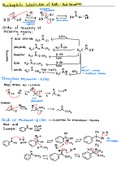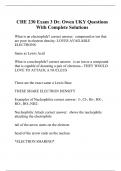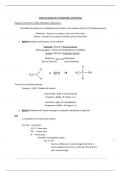Nucleophiles - Study guides, Class notes & Summaries
Looking for the best study guides, study notes and summaries about Nucleophiles? On this page you'll find 156 study documents about Nucleophiles.
Page 4 out of 156 results
Sort by

-
CHE 230 EXAM 3 Questions With Complete Solutions
- Exam (elaborations) • 4 pages • 2023
- Available in package deal
-
- $10.99
- + learn more
Is SN2 concerted or stepwise correct answer: Concerted Is SN1 concerted or stepwise correct answer: Stepwise When is there a change in configuration in an SN2 correct answer: When alpha position is a chiral center What type of substrate reacts most quickly for SN2 correct answer: Primary What type of substrate reacts most quickly for SN1 correct answer: Tertiary (bc more stable carbocation) What type of nucleophiles favor SN2 correct answer: Strong List 9 strong nucleophi...

-
CHEM 215 Exam 2 Study Guide
- Summary • 13 pages • 2022
- Available in package deal
-
- $3.99
- 2x sold
- + learn more
This study guide will help you get an A on Exam 2 in CHEM 215 :) It is a summary of Exam 2 content containing colorful diagrams, drawings, and mechanisms. This study guide paired with practice problems will help any student succeed in this course. The study guide contains information from Exam 2 including: -Acylation mechanisms (strong base, weak base, acid catalyst, special cases) -Reactivity of different functional groups -Preparation and reactions of carboxylic acids, anhydrides, esters...

-
Test Bank for Organic Chemistry 4th Edition by David R. Klein | 9781119659594 |2021-2022 |Chapter 1-27 | All Chapters with Answers and Rationals
- Exam (elaborations) • 2151 pages • 2023
-
- $42.98
- + learn more
Test Bank for Organic Chemistry 4e 4th Edition by David R. Klein. ISBN-13: 9594 Full chapters test bank PDF TABLE OF CONTENTS 1 A Review of General Chemistry: Electrons, Bonds, and Molecular Properties 1 1.1 Introduction to Organic Chemistry 2 1.2 The Structural Theory of Matter 3 1.3 Electrons, Bonds, and Lewis Structures 4 1.4 Identifying Formal Charges 7 1.5 Induction and Polar Covalent Bonds 8 1.6 Reading Bond-Line Structures 11 1.7 Atomic Orbitals 14 1.8 Valence Bond Theory 17 1.9 Molecular...

-
LMR OC 3: Aldehydes and Ketones 2 Questions and answers
- Exam (elaborations) • 3 pages • 2024
-
Available in package deal
-
- $7.99
- + learn more
Acidity of α-Hydrogen: Carbonyl α-carbon: Next to the carbonyl carbon. α-Hydrogen: H of alpha carbons Oxygen pulls electron density out of these C-H bonds so it's easier to deprotonate the α-carbon of aldehydes/ketones. How do you increase the acidity of α-Hydrogen? - Resonance stability provided by the conjugate base - Resonance can stabilize enolate intermediate, since negative charge is distributd to more EN oxygen atom - Alpha hydrogen can easily deprotonate in basic solutions...

-
PSU Chem 210 Final Review Questions & Answers(Graded A)
- Exam (elaborations) • 3 pages • 2024
- Available in package deal
-
- $14.49
- + learn more
E2 Reaction - ANSWEROne-Step with no intermediates, Base takes off proton + LG leaves with double bond formation. What type of carbons do E2 rxns favor? - ANSWERTertiary What is a Zaitsev product? - ANSWERDouble bond formation on more substituted carbon What is a Hoffman product? - ANSWERDouble bond formation on less substituted carbon When using a stericallly hindered base (t-BuOK, LDA), which product is more favorable? - ANSWERHoffman When using Eto- or less sterically hindered ...

-
CHE 230 Exam 3 Dr. Owen UKY Questions With Complete Solutions
- Exam (elaborations) • 9 pages • 2023
- Available in package deal
-
- $11.49
- + learn more
What is an electrophile? correct answer: compound or ion that are poor in electron density- LOVES AVAILABLE ELECTRONS Same as Lewis Acid What is a nucleophile? correct answer: is an ion or a compound that is capable of donating a pair of electrons-- THEY WOULD LOVE TO ATTACK A NUCLEUS These are the exact same a Lewis Base THESE SHARE ELECTRON DENSITY Examples of Nucleophiles correct answer: I-, Cl-, Br-, HS-, RO-, HO-,NH2- Nucleophilic Attack correct answer: shows the nuc...

-
AAMC MCAT Practice Exam 1 QUESTIONS AND ANSWERS RATED A+ 2023|2024
- Exam (elaborations) • 61 pages • 2023
-
- $13.49
- + learn more
AAMC MCAT Practice Exam 1 QUESTIONS AND ANSWERS RATED A+ 2023|2024 In the chromatography of the reaction mixture, water absorbed on cellulose functioned as the stationary phase. What was the principal factor determining the migration of individual components in the sample? A) Hydrogen bonding B) Solute concentration C) Stationary phase concentration D) Thickness of paper - Answer - A) Hydrogen bonding The answer to this question is A because the relative amount of hydrogen bonding to t...

-
AQA A Level Chemistry 2022 Paper 2 SOLUTION 2023//2024
- Exam (elaborations) • 5 pages • 2023
-
- $9.99
- + learn more
How can we make polymers more flexible? - ANSWER By adding a plasticiser How do plasticisers make polymers more flexible? - ANSWER They stick between the chains and keep the polymers further apart from each other, weakening the van der Waals forces and lets chains slide more easily. Uses of Kevlar - ANSWER bulletproof and used in body armour. Uses of Nylon - ANSWER commonly used in textiles. Why are polymers strong? - ANSWER Polymers are bound by van der Waals forces. The intermolecula...

-
PSU Chem 210 Final Review Questions with Correct Solutions | Graded A+
- Exam (elaborations) • 3 pages • 2023
-
Available in package deal
-
- $8.99
- + learn more
E2 Reaction - One-Step with no intermediates, Base takes off proton + LG leaves with double bond formation. What type of carbons do E2 rxns favor? - Tertiary What is a Zaitsev product? - Double bond formation on more substituted carbon What is a Hoffman product? - Double bond formation on less substituted carbon When using a stericallly hindered base (t-BuOK, LDA), which product is more favorable? - Hoffman When using Eto- or less sterically hindered base, which pro...

-
Chemical properties of Aldehydes and Ketones
- Exam (elaborations) • 45 pages • 2024
-
- $9.49
- + learn more
Chemical properties of Aldehydes and Ketones Reactions common to both Aldehydes and Ketones The difference between an Aldehyde and a Ketone is the position of the C=O (Carbonyl group). Aldehyde – always on a carbon at the end of the chain Ketone – Always on a carbon at middle carbon of the chain 1. BOTH Aldehydes and Ketones can be reduced Aldehyde reduced to Primary Alcohol Reducing agent = Sodium tetrahydroborate III (NaBH4) Ketone reduced to Secondary Alcohol ...

How much did you already spend on Stuvia? Imagine there are plenty more of you out there paying for study notes, but this time YOU are the seller. Ka-ching! Discover all about earning on Stuvia


